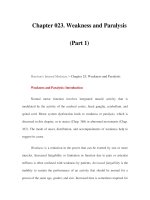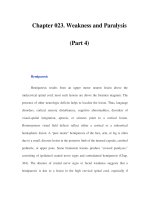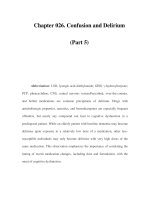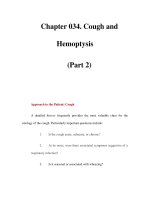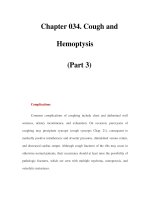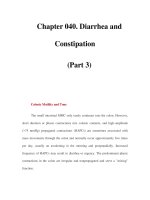Chapter 048. Acidosis and Alkalosis (Part 10) pps
Bạn đang xem bản rút gọn của tài liệu. Xem và tải ngay bản đầy đủ của tài liệu tại đây (67.48 KB, 6 trang )
Chapter 048. Acidosis and
Alkalosis
(Part 10)
Differential Diagnosis
To establish the cause of metabolic alkalosis (Table 48-6), it is necessary to
assess the status of the extracellular fluid volume (ECFV), the recumbent and
upright blood pressure, the serum [K
+
], and the renin-aldosterone system. For
example, the presence of chronic hypertension and chronic hypokalemia in an
alkalotic patient suggests either mineralocorticoid excess or that the hypertensive
patient is receiving diuretics. Low plasma renin activity and normal urine [Na
+
]
and [Cl
–
] in a patient who is not taking diuretics indicate a primary
mineralocorticoid excess syndrome. The combination of hypokalemia and
alkalosis in a normotensive, nonedematous patient can be due to Bartter's or
Gitelman's syndrome, magnesium deficiency, vomiting, exogenous alkali, or
diuretic ingestion. Determination of urine electrolytes (especially the urine [Cl
–
])
and screening of the urine for diuretics may be helpful. If the urine is alkaline,
with an elevated [Na
+
] and [K
+
] but low [Cl
–
], the diagnosis is usually either
vomiting (overt or surreptitious) or alkali ingestion. If the urine is relatively acid
and has low concentrations of Na
+
, K
+
, and Cl
–
, the most likely possibilities are
prior vomiting, the posthypercapnic state, or prior diuretic ingestion. If, on the
other hand, neither the urine sodium, potassium, nor chloride concentrations are
depressed, magnesium deficiency, Bartter's or Gitelman's syndrome, or current
diuretic ingestion should be considered. Bartter's syndrome is distinguished from
Gitelman's syndrome because of hypocalciuria and hypomagnesemia in the latter
disorder. The genetic and molecular basis of these two disorders has been
elucidated recently (Chap. 278).
Table 48-6 Causes of Metabolic Alkalosis
I. Exogenous HCO
3
-
loads
A. Acute alkali administration
B. Milk-alkali syndrome
II. Effective ECFV contraction, normotension, K
+
deficiency, and
secondary hyperreninemic hyperaldosteronism
A. Gastrointestinal origin
1. Vomiting
2. Gastric aspiration
3. Congenital chloridorrhea
4. Villous adenoma
B. Renal origin
1. Diuretics
2. Posthypercapnic state
3. Hypercalcemia/hypoparathyroidism
4. Recovery from lactic acidosis or ketoacidosis
5. Nonreabsorbable anions inc
luding penicillin,
carbenicillin
6. Mg
2+
deficiency
7. K
+
depletion
8. Bartter's syndrome (loss of function mutations
in TALH)
9. Gitelman's syndrome (loss of function
mutation in Na
+
-Cl
-
cotransporter in DCT)
III. ECFV expansion, hypertension, K
+
deficiency, and
mineralocorticoid excess
A. High renin
1. Renal artery stenosis
2. Accelerated hypertension
3. Renin-secreting tumor
4. Estrogen therapy
B. Low renin
1. Primary aldosteronism
a. Adenoma
b. Hyperplasia
c. Carcinoma
2. Adrenal enzyme defects
a. 11 α-Hydroxylase deficiency
b. 17 α-Hydroxylase deficiency
3. Cushing's syndrome or disease
4. Other
a. Licorice
b. Carbenoxolone
c. Chewer's tobacco
IV. Gain-of-
function mutation of renal sodium channel with
ECFV expansion, hypertension, K
+
deficiency, and hyporeninemic
-
hypoaldosteronism
A. Liddle's syndrome
Note: ECFV, extracellular fluid volume; TALH, thick ascending limb of
Henle's loop; DCT, distal convoluted tubule.

